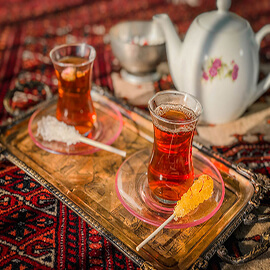
Persian Tea
| Food 2019-12-29 16:50:30
Tea, is one of the most important cornerstones of Iranian culture...
The kettle contains tea, one of the most important cornerstones of Iranian culture, and the tea house is its centuries-old keeper.
Qajar attempts to grow tea in Iran had been unsuccessful until Haj Mohammad Mirza, also known as Kashef-ol Saltaneh, was sent to India as the Iranian consulate. He managed to learn the secrets of tea plantation and slipped home to Lahijan with some 4000 tea plants and the rest is history.
At the time the English had a strict monopoly of tea production in India, with rigid rules against non-Europeans engaging in this trade. Kashef Al Saltaneh, who had studied in Paris as a young man and was fluent in French, went to India, posed as a French businessman, learned the trade and smuggled some tea saplings and seeds to Iran.
After six years of experimentation, he introduced his first product to the market, and started the industry that revolutionalized the economy of two northern states, Gilan and Mazandaran, and made Iranians avid tea drinkers.
He is known today as the father of Iranian Tea, and his mausoleum, in the city of Lahijan, houses the tea museum.”
Iranians have one of the highest per-capita rates of tea consumption in the world and since old times every street has a Châikhâne (Tea House). Châikhânes are still an important social place where older generations gather with their friends for a chat over a delightful cup of Persian tea.
Most Châikhânes or Persian tea houses will serve tea on the stronger.
Persian tea comes in a variety of subtle flavours, but its defining characteristic is its deep reddish-brown colour, which tea-drinkers can choose to dilute with water depending on their preference. It’s not that easy to find a glass of fair Persian tea and most of the tea in restaurants or cafes is cheaper leaves from Ceylon.
Because of the black tea’s bitterness, many prefer to have sugar with their Persian tea. The traditional way to do this is to take a sugar cube and place it between your teeth and then sip the tea while allowing the sugar to melt. You could also dissolve a saffron rock candy in your tea before you drink it.
Iranians, especially in colder regions of the country drink multiple cups of tea throughout the day.
Fun fact: Between Iranian ethnicities, Azeris are well-known for drinking a lot of tea. Actually, people in Iranian Azerbaijan region are super obsessed with their Persian tea and they always drink it freshly brewed in a narrow-waisted glass or cup.
Any Persian will tell you that they love to drink Chai, pronounced Cha-ee.
Tea, in general, is what Persians drink in the morning, after each meal, and not to mention throughout the day. Additionally, the first drink that one if offered when visiting someone else’s home is usually a cup of Persian tea.